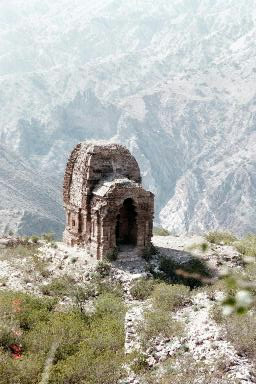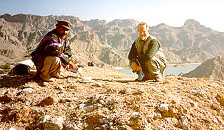Salt Range Temples, Pakistan
Michael W. Meister, W. Norman
Brown Professor,
Department of the History of Art, University of Pennsylvania, and Curator,
Asian
Section, University of Pennsylvania Museum of Archaeology and
Anthropology, has served as Chair, Department of
South Asia Studies, and Director,
South Asia Center
Along the Indus river and in the Salt Range mountains, temples
dating
from the sixth to the early eleventh century survive in upper Pakistan. A
joint project with Professors Abdur Rehman, past Chairman of the
Department of
Archaeology, University of Peshawar, and Farid Khan, founder of the
Pakistan Heritage
Society, has begun to analyse and
document these important monuments in the history of South Asian temple
architecture with funding from the University of Pennsylvania. Two
seasons of excavation have been carried out at the site of North
Kafirkot.
 A preliminary
review and analysis of this tradition, "Temples Along the
Indus," has been published in the University of Pennsylvania
Museum's journal, Expedition,
38.3 (1996): 41-54. (The text as well
as a preliminary
typescript of this article are available on the Web.)
A preliminary
review and analysis of this tradition, "Temples Along the
Indus," has been published in the University of Pennsylvania
Museum's journal, Expedition,
38.3 (1996): 41-54. (The text as well
as a preliminary
typescript of this article are available on the Web.)
 We discovered an important new temple
designated temple E through excavations undertaken at north
Kafirkot in 1997. A report on both seasons of excavation has
been published in Expedition. 42.1 (2000): 37-46.
We discovered an important new temple
designated temple E through excavations undertaken at north
Kafirkot in 1997. A report on both seasons of excavation has
been published in Expedition. 42.1 (2000): 37-46.
(See also a full list of
project publications below.)
Recent views of Kafirkot in Feb. 2000 following excavation are also
available, as well as two hypothetical
reconstructions of temple E based on neighboring temple A.
Salt Range Workshop
An international Workshop on the Salt Range Culture Zone was held at the
University of
Pennsylvania and the University of Wisconsin, Madison, in April 2004, with
the
sponsorship of the American Institute of Pakistan Studies.
Amb
Further archaeological work and exploration was begun at
the
Salt-Range site
of
Amb, in association with the Department of Archaeology and
Museums,
Government of the Punjab.


Amb, temples A and B
Support for this project has been received from
the Middle East Center,
South Asia Regional Studies Department, the University of Pennsylvania
Research Foundation, and the American Institute of Pakistan Studies.

Sites
- Taxila,
fifth-century encasement of Dharmarajika stupa
- Murti, stupa mound and Gupta-period temple-remains
- Katas,
pilgrimage site, tank, and temples
- North Kafirkot, fortress, citadel,
and temples;
destroyed temple at Kanjari-kothi
compared to temple B; the site of the newly discovered
temple E is just south of temple A.
- Bilot (South Kafirkot), fortress,
citadel, and temples
- Mari-Indus,
four temples and habitation site
- Kalar,
brick temple
-
Amb, fort and two temples
- Malot,
temple and gateway
- Shivganga,
grove, tank, and temple ruins
- Nandana,
fort, temple, and platform
For more views of these monuments, see also Selected
Enlarged
Views of Salt Range Temples.
Salt Range Temple Project Publications
Michael W. Meister -
"Architectural Originality in the Punjab." Kal‚,
Journal of Indian
Art History Congress 6 (1999-2000): 27-35.
-
"Chronology of Temples in the Salt Range, Pakistan." In South Asian
Archaeology 1997, ed. Maurizio Taddei and Giuseppe De Marco. Rome:
Istituto Italiano per l'Africa e l'Oriente, 2000, pp. 1321-39.
-
"Crossing Lines, Architecture in Early Islamic South Asia," Res,
Anthropology and Aesthetics 43 (2003): 117-30.
-
"Gandh‚ra-N‚gara Temples of the Salt Range and the Indus."
Kal‚,
the Journal of Indian Art History Congress 4 (1997-98): 45-52.
-
"Malot and the Originality of the Punjab." Punjab Journal of
Archaeology and History 1 (1997): 31-36.
-
"Pattan Munara: Minar or Mandir?" In Hari Smiriti: Studies in Art,
Archaeology and Indology, Papers Presented in Memory of Dr. H.
Sarkar,
New Delhi: Kaveri Books, 2006.
-
"Temples Along the Indus." Expedition, the
Magazine
of the University of Pennsylvania Museum of Archaeology and Anthropology
38.3 (1996):
41-54.
[.pdf
available]
-
"Temples of the Salt Range." In Religion, Ritual & Royalty,
ed.
N.
K. Singhi and Rajendra Joshi, pp. 132-39. Jaipur: Rawat Publications,
1999.
- "Discoveries on the Indus." In The Ananda-Vana of Indian Art,
ed. Naval Krishna and Manu Krishna, pp. 95-102. New Delhi: Indica.
In Press
-
"Northwest India and the Punjab." In M. A. Dhaky , ed., Art and
Architecture in India: North Indian Art and Architecture
(Pre-Medieval).
- "The Problem of Platform Extensions at Kafirkot North," Ancient
Pakistan.
-
"Restoring Temples in the Kafirkots, N.W.F.P., and Katas, Panjab,
to Discussions of the Origins of N‚gara." In M. S. Nagaraja Rao, ed.
K. V. Ramesh Felicitation Volume.
- Temple Conservation and Transformation." In South Asian Archaeology
1999, ed. K.R. van Kooij and E.M. Raven, Leiden.
Michael W. Meister with Abdur Rehman-
"Archaeology at Kafirkot." In Catherine Jarrige and
Vincent Lefevre, ed., South Asian Archaeology 2001, Paris:
Editions
Recherche sur les Civilisations, 2005, pp. 571-78.
Michael W. Meister, Abdur Rehman, and Farid Khan -
"Discovery of a New Temple on the Indus." Expedition,
42.1 (2000): 37-46.
[.pdf available]
-
"Temples of the Indus & the Salt Range, A Fresh Probe (1995-97)."
The Pakistan Heritage Society Newsletter 1 (1998): 2-5.
Abdur Rehman-
"The Discovery of Siva-Mahesvara Figure at Kafirkot." Lahore
Museum Bulletin 9/2 (1996) [1998]: 51-56.

Farzand Masih
A student of Professor Abdhur Rehman's at the University of
Peshawar, and
team representative of the Department of Archaeology and Museums,
Government of
Pakistan, Farzand Masih travelled and worked with the Salt Range
Project for
several
seasons while he prepared a doctoral dissertation, "Temples of the
Salt Range and North and South Kafirkot: Detailed Analysis of Their
Architecture and Decorative Designs" (Department of Archaeology,
University of Peshawar, 2000). He is now an Assistant Professor of
Archaeology,
Department of History, University of the Punjab, Lahore. He has
recently published parts of the dissertation:-
(with Shahbaz Khan) "Kallar - a Brick Temple." Journal of the Punjab
University Historical Society, XXV (2000): 105-09.
-
"Temples of the Salt Range and Kafir Kot: Ornamentation." Lahore Museum
Bulletin XIII.2 (2000): 33-36.
-
"An Extant Hindu Sahi Temple at Nandana." In Sohdra, History &
Archaeology, by Abudl Aziz Farooq. Majlis-i-Sqafat Sohdra
(Gujranwala), pp. 81-94.
-
"Temples of North Kafir Kot." Indo Koko Kenkyu 22 (2001):
101-22.
-
"A Seventh Century Temple at North Kafir Kot." Lahore Museum
Bulletin XIV.1 (2001): 1-8.
-
"Style of the Salt Range and Kafir Kot Temples in Pakistan: A Critical
Analysis." Pakistan Vision III.1-2 (2002): 105-40.
last
modified 3 March 2006
Michael W. Meister, mmeister@sas.upenn.edu
 A preliminary
review and analysis of this tradition, "Temples Along the
Indus," has been published in the University of Pennsylvania
Museum's journal, Expedition,
38.3 (1996): 41-54. (The text as well
as a preliminary
typescript of this article are available on the Web.)
A preliminary
review and analysis of this tradition, "Temples Along the
Indus," has been published in the University of Pennsylvania
Museum's journal, Expedition,
38.3 (1996): 41-54. (The text as well
as a preliminary
typescript of this article are available on the Web.)




